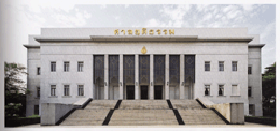Group Building no.22
the complex of the Court of Justice

depicted item: Exterior and interior of the complex of the Court of Justice
source: Parinya Chukaew and Architectural Heritage in Thailand II
date: 2014
1. Identity of building/ group of buildings/ urban scheme/ landscape/ garden

1.1 current name of building: the complex of the Court of Justice
1.2 variant or former name: the complex of the Court of Justice
1.3 number & name of street: Ratchadamnoen Rd., Phra Borom Maha Ratchawang
1.4 town: Phra Nakhon
1.5 province/state: Bangkok
1.6 zip code: 10200
1.7 country: Thailand
1.8 national grid reference:
1.9 classification/ typology: ADM
1.10 protection status & date: owned by Ministry of Justice and received the Architectural Conservation Awards 2009 from the Association of Siamese Architects Under Royal Patronage
2. History of building
2.1 original brief/ purpose: ADM
2.2 date completion: 1939-1943
2.3 architectural and other designers: Phra Sarocharattanimmaan (Saroch Sukkayang)
2.4 others associated with building: the Court of Appeals and the Supreme Court
2.5 significant alterations with dates: under the threat of demolition since 2007
2.6 current uses: the Court of Justice
2.7 current condition: partly demolished
3. Description
3.1 general description: The complex of the Court of Justice was established in 1939 by Phra Sarocharattanimmaan (Saroch Sukkayang). Before drawing the plans, the government sent him to visit a court in Singapore and bring back architectural information. The opening ceremony of the Court of Justice was held in 1941 by Phra Ong Jao Atit Tiphaya Apa. The buildings are laid out in a 'V' shape divided into three sections. The first section was built in 1939 for the Court of Justice. The second section is the building nearby the 'Ku Muang Doem Canal', completed in 1943. This section is used as the Court of Appeals. The third section is the Supreme Court. It sits on the site of a former justice Court used during the reign of King Rama V that was demolished in 1959. In 1963, a new building was erected and installed as the Supreme Court.
3.2 construction: reinforced concrete structure and flat slab roof
3.3 context: The complex of the Court of Justice is located in the Bangkok inner city where many nationally important buildings were built.
4. Evaluation
4.1 technical: The main structure of the Court of Justice, the Court of Appeals and the Supreme Court were constructed by reinforced concrete. The three buildings have symmetrical rectangular plans and entrance at the center with large pillars.
4.2 social: The construction of the Court of Justice complex was built to celebrate sovereignty of Thai legislative body.
4.3 cultural & aesthetic: The three buildings were influenced by modernism, which were the main architectural trend of that period. The latest building, the Supreme Court, was only one building which was decorated by simplified Thai decorative arts. Its Modern architectural style was popular in the period after the 1932 revolution.
4.4 historical: The entire construction is a valuable national architectural heritage site and the land it is built on has a long history as a Justice Court.
4.5 general assessment: The building exposes the arts and architectural styles of the old period and represents a good source of knowledge on our national history, our society and political system. Therefore, the Department of Fine Arts announced that the Court of Justice complex should be registered as a national historic building. Thus, the buildings of the Justice Court and the Supreme Court are worthy of being preserved.
5. Documentation
5.1 principal references: Parinya Chukaew and Architectural Heritage in Thailand II
5.2 visual material attached: Parinya Chukaew and Architectural Heritage in Thailand II
5.3 rapporteur/ date: June 2014
6. Fiche report examination by ISC/R
name of examining ISC member:
date of examination:
approval:
working party/ref. n° :
NAi ref. n°:
comments:
Explanation of selection
The concept of modernist architecture was well-known during the reign of King Rama V by groups of Thai students who studied in Europe. However, the popularity of this style did not become wide spread until after the revolution of 1932 where the modernist style can now be found in various important public buildings.
